Content creation has become much faster due to artificial intelligence technology. Just by entering a prompt, AI tools present you with a convenient result within a few seconds.
But, how to humanize AI content? Because AI-generated content is often robotic sounding and lacks the human touch. AI tools may have made writing content easier but they can also easily tamper with your brand voice. That’s why it’s important to humanize AI content.
In this blog, we’ve discussed the important tools needed to humanize AI content. So, let’s get started!
Why Is It Important to Humanize AI Content?
Over the years AI has improved impressively in speed, efficiency & convenience. However, it still needs human supervision to produce better results. Here is why AI content should be humanized:
AI is still not Perfect
AI-generated text is hit-or-miss content. The results are often concise & neatly written, but other times it’s a bunch of spam words that make no sense. So, for human consumption, the draft needs to be humanized.
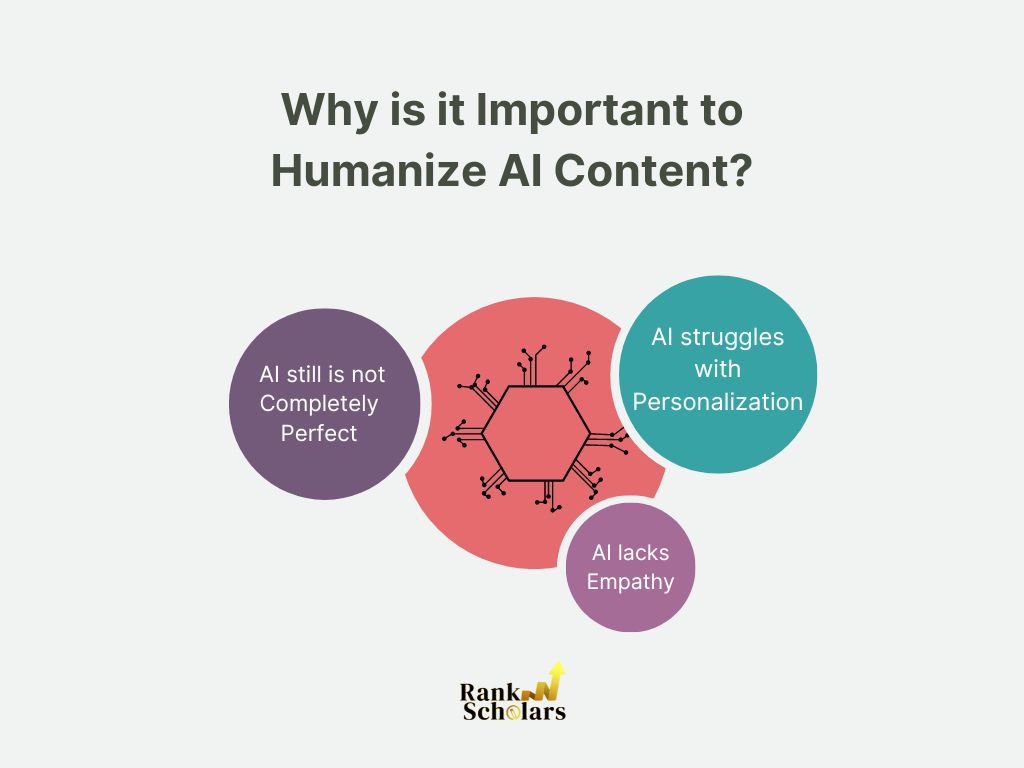
AI lacks Empathy
Since AI content generation largely relies on algorithms, the result becomes repetitive. For user-friendly content, empathy connects the content to the right audience. Humanizing AI-generated content is necessary to communicate with your audience authentically.
AI struggles with Personalization
Customers prefer personalized content to generic ones. Human writing resonates with customers due to common experiences & expressions. For better conversions, spend some time editing the AI-generated draft.
Also Read: 30 FREE Content Writing Tools For Your Blog
How to Humanize AI Content: 10 Effective Ways
AI tools are highly efficient in creating content by generating ideas and drafts quickly. But, how to humanize AI content to make the output more effective? Here’s how:
1. Train the AI to Match your Style
Some AI tools allow you to train the AI in such a way that it matches your writing style.
How does it Help?
You can provide AI with examples of your writing style, vocabulary preferences, tone, and voice. Now, you can ensure that the generated content aligns with your desired brand or personal identity.
How to do this?
AI tools such as GPT-3 allow you to provide customized instructions as prompts. The output of such prompts results in human-sounding content instead of robotic.
Example
Share examples of your previous writing or any content that aligns with your style. Use these as reference points for your AI to follow & generate content in a similar style. Remember it’s a process of trial and error for the AI to match your desired style.
2. Give Detailed and Specific Prompts
When using AI tools to generate content, provide detailed and specific prompts that can achieve human-like outputs.
How does it Help?
Detailed prompts help AI to tailor its output accordingly, resulting in more human-like content. Instead of settling for a generic text, “Write me a blog post about [ ]”, you can guide your AI with a clear tone & detailed direction.
How to do this?
GPT-3 allows the users to fine-tune the output by providing specific prompts. You can provide guidelines such as the target audience, desired tone (formal, casual, humorous), key points to cover, and any examples or references. With a clear prompt, AI can generate content that aligns with your expectations.
Example
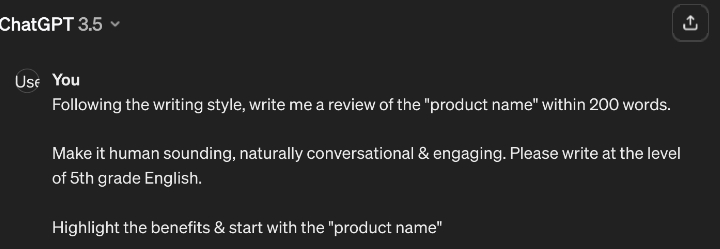
The AI-generated content heavily depends on the specificity and clarity of the prompts provided. By giving detailed instructions, content creators can create humanized content with AI tools.
3. Add Personal Experiences and Anecdotes
Adding real-life stories and personal reflections through storytelling can make your content more relatable and engaging.
How does it Help?
Sharing personal experiences and anecdotes allows readers to connect with the content on an emotional level. This approach captures the reader’s attention quickly & encourages them to read till the end.
How to do this?
After using AI to generate the content, identify the key points where you can insert your personal stories related to the topic. Share your own experiences. Be genuine and transparent to connect with your audience on a deeper level.
Example
Suppose you’re writing a blog post about “Productivity Tips & Tools”. You can use AI to generate a bulk of the content about this. Then you can share a personal anecdote about how a particular tool helped you to accomplish a goal. This adds authenticity to your content and makes it more compelling for readers.
4. Use Emotional Language to Set the Mood
Using emotional language in your AI-generated content is like adding seasoning to a dish, it enhances the flavor. Whether it is a personal anecdote or a how-to guide, this creates an emotional connection that can dramatically elevate your content.
How does it Help?
Adding emotional language adds depth to the AI content. This makes it more relatable and interesting. Emotions help your audience build trust in your brand.
How to do this?
To implement emotions effectively, use descriptive adjectives & sensory details in your AI-generated content to make it more engaging. Use storytelling in your writing to tap into the five senses, i.e. touch, taste, sound, scent, and sight to draw your audience’s attention to the content.
Example
Suppose you’re writing a blog post about fitness. Instead of simply listing the workouts, include your journey on how you decided to become a fitness instructor and what is your favorite workout & why.
5. Cross-check Facts & Stats
AI-generated text may contain inaccuracies and inconsistencies. Many systems have been trained on two-year-old data, resulting in outdated output.
How does it Help?
Cross-checking AI-generated content before publishing it ensures a high-quality output that is both accurate & trustworthy. By verifying facts, statistics, and claims, content creators eliminate the risk of spreading misinformation and avoid causing trust issues with their audience.
How to do this?
Take the time to thoroughly verify the facts, statistics, or claims made within the AI content to ensure accuracy. To fact check use reliable sources such as Google Scholar and Statista.
Example
Let’s say, the AI content provides information about climate change. Before sharing this content – Fact-check the current information from reputed scientific journals & documents. By verifying the accuracy, you can ensure the content is reliable & trustworthy for your audience.
6. Replace Common Words
AI content often repeats the same words. Hence, the readability of such content is not smooth. To enhance the quality, replace these words to create a more dynamic and flowy reading experience.
How does it Help?
Recognize and rewrite the repeated words & phrases. This breaks the monotony and makes the content easier to read. By using vocabulary variations and expressions, you can maintain the reader’s attention and convey information more effectively.
How to do this?
You must identify repetitive words and phrases from the list below and use alternative words to maintain the same meaning. It’s better to replace those words from the draft before publishing the content for an engaging read to your audience.
Example
Following is the list of some of those words:
- “Critical”, “crucial”, “essential”, “importantly”
- “In conclusion”, “in summary”, “ultimately”
- “Furthermore”, “moreover”, “additionally”
- “Realm”, “embark”, “reinforce”
- “Navigate” i.e. “ Navigating the complexities…”
- “Landscape” i.e. “ The landscape of…”
- “Evolving”, “exploring”, “robust”, “flourish”
- “Bustling”, “vibrant”, “hustle and bustle”
7. Format it the Right Way
AI content is often filled with lengthy sentences with heavy, repetitive words. For a pleasant read, effective formatting is the key.
How does it Help?
Proper formatting enhances readability as it breaks down information into digestible chunks. You can use bullet points, short paragraphs, and include links to keep the reader’s attention intact while providing credibility to the overall content.
How to do this?
Remember to mimic how you speak and communicate naturally while providing instructions to AI tools. When giving prompts to the AI tool, provide instructions mentioning the key points you want to include. Here’s how to format the content:
- Break down information into bullet points, offering easy digestion of key points.
- Short paragraphs maintain the reader’s engagement throughout the end.
- Combine short sentences with longer ones to emphasize certain points.
- Include relevant links that provide additional resources, and context resembling human writing. This solidifies your content credibility.
Example
Suppose you’re instructing an AI tool to generate content about “The Benefits of Meditation”. Instead of requesting a lengthy paragraph, provide a prompt such as,
“Write about the benefits of meditation. Format the content with bullet points to highlight topics like stress reduction, improved focus, and emotional well-being. Keep the paragraphs short to maintain reader engagement. Mix sentence lengths to vary the pace and include links to scientific studies or meditation resources for credibility.” This approach ensures that the AI-generated content is well-formatted, engaging, and credible.
8. Add Relevant Media
Including relevant media in your content makes it human-like text, offering a great reading experience for your audience.
How does it Help?
Visuals connect with your readers on a personal level. Including a relevant image that complements the written content leaves a lasting impression on readers. Visual content breaks up the monotony of text and helps the readers understand the concept better.
How to do this?
Choose visual elements that are relevant to the written content. This may include stock images, infographics, videos, or GIFs. Ensure that the visual content aligns with the tone of the written text.
Example
For instance, if you’re writing about outdoor camping, include images of camping locations, camping gear, or instructional videos demonstrating camping techniques. Make sure to pair informative text with visually appealing media to make the content more enjoyable for your audience.
9. Use AI Checker Tools
AI checker tools are important to evaluate the human-like quality content generated by AI. Use these tools to enhance the humanization of AI-generated content.
How does it Help?
AI checker tools review the content to detect any traces of AI generation. This is a useful step to evaluate how humane your content is after editing.
How to do this?
If your text is labeled “AI-generated” even after editing, revise the content once again. Try to focus on the sentences that sound generic or lack characters. Re-edit them to add personality, tone, and unique insights.
Example
Suppose you’ve edited an AI-generated blog post about “Travel Destinations”. However, the AI checker tool still flags certain paragraphs as “AI-generated.” To humanize the content, rewrite these sections by adding details & descriptive language to make it more humane & relatable to the readers.
10. Use it to Get Ideas, Research, and Strategize
AI is not a replacement for humans. Instead, it’s more like an assistant to accelerate the writing process.
How does it Help?
Treat AI as a writing assistant. Use AI tools to generate ideas, research, and plan your strategies. AI is like having a smart friend who helps you figure out what people want to read about. AI can improve your writing process but it’s not an alternative.
How to do this?
Use AI- tools to generate suggestions and recommendations for a given topic. Input your knowledge along with AI-generated content & and make the content quality better. The collaborative approach between humans and AI ensures that the final output resonates with readers on a deeper level.
Example
Suppose you’re writing about “Digital Marketing Trends”. Instead of starting from scratch, use AI tools to generate relevant topic ideas based on current industry trends. Then, go through further research with AI assistance to gather data and insights to support your points.
Finally, combine your writing skills with AI-generated suggestions and create an informative article that resonates with your target audience.
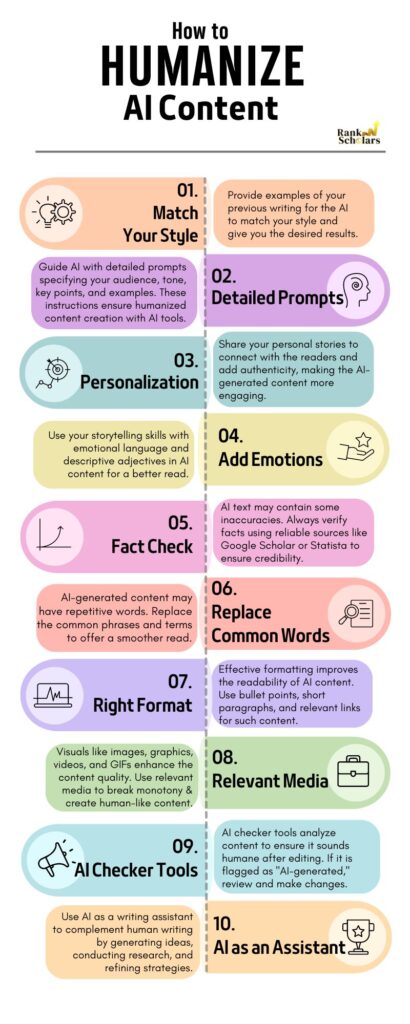
Also Read: 7 Benefits Of Content Writing For Business
5 Tools to Humanize AI Content
Several tools humanize the AI-generated content and remain invisible to detection by search engines. Wondering about the best ones? Here are the 5 AI humanizer tools you might want to have a look at.
1. Undetectable AI
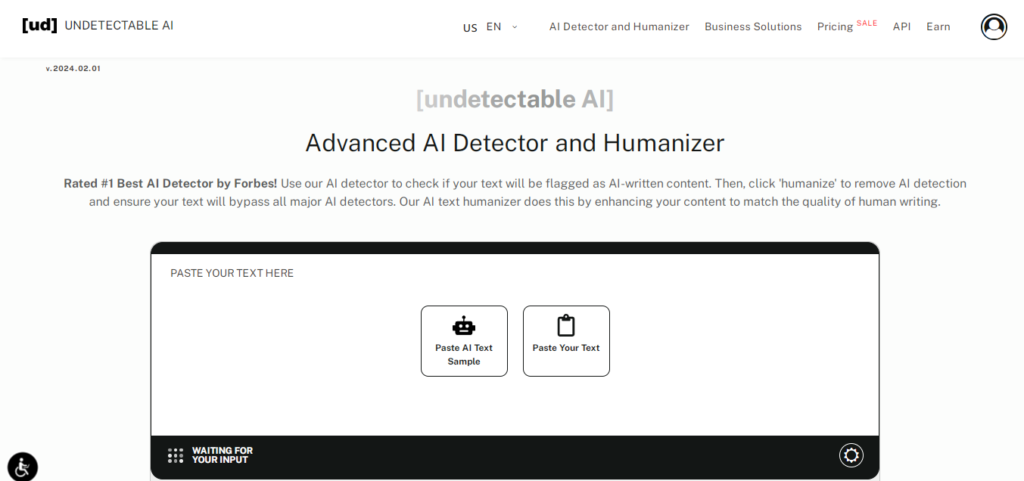
Undetectable AI resembles human-written content. Since it uses advanced algorithms, the content smoothly bypasses AI detection every time.
Key Features
- Quickly produces quality, keyword-rich content.
- Every piece of generated content is plagiarism-free.
- It is suitable for all types of content, including blogs, product descriptions, landing pages, and social media posts.
- Bypass AI content detectors.
How to Use?
Write down your desired topic or keywords. With this, Undetectable.ai will generate human-like content that meets your requirements.
2. Humbot

Humbot creates engaging & authentic text just like a human writer. The content is well-written without any grammatical or spelling errors.
Key Features
- Humbot produces well-written, error-free content.
- Content can be input as text, file, or url.
- Bypass AI detection tools easily.
- Offers a free trial plan for up to 300 words.
How to Use?
Humbot is easy to use. Just write down or paste the text you want to humanize and click “Start Humanizing” to initiate the process. You can receive the result within a minute.
3. BypassGPT
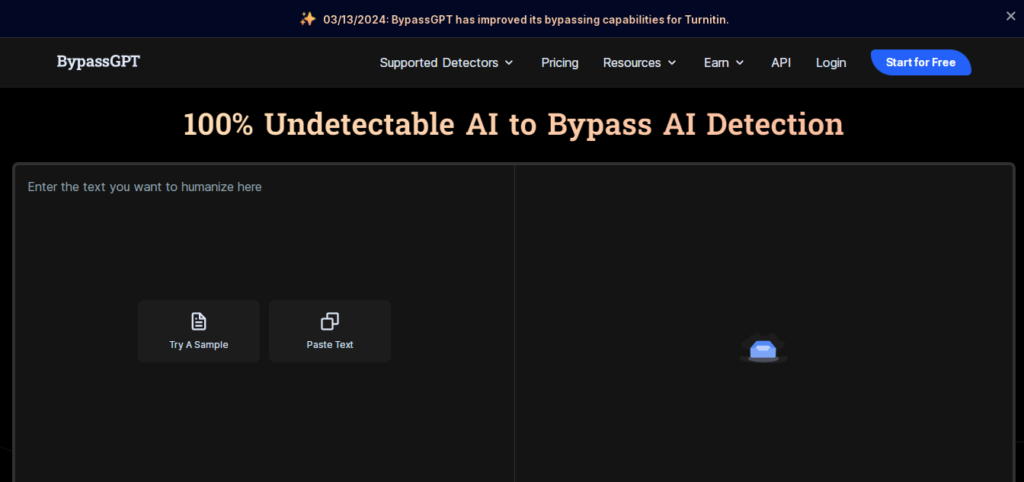
BypassGPT not only changes a few words of the content but it also delivers wonderful responses every time. The advanced machine learning accurately mimics human writers and easily bypasses AI detection tools.
Key Features
- Plagiarism-free content creation.
- Human-like engaging content that bypasses AI checkers successfully.
- Offers a free plan with up to 300 words.
How to Use?
Enter or paste the text you want to humanize and click the “Humanize” button. You’ll get the result within a moment.
4. AI Humanizer
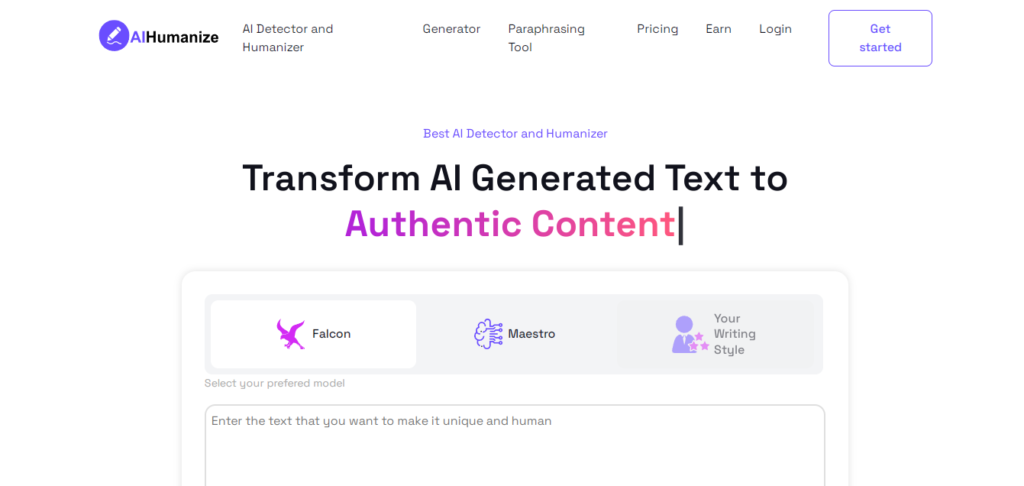
AI Humanizer helps professionals and content creators to create content faster. It humanizes the AI content in an undetectable way to the AI checkers.
Key Features
- Full customization options are available.
- Successfully bypasses AI detection tools.
How to Use?
AI Humanizer has a simple interface and is easy to use. After signing up, select the desired bypass mode and input the text you want to humanize. Then, customize the humanization settings and let the tool do the job.
5. StealthWriter
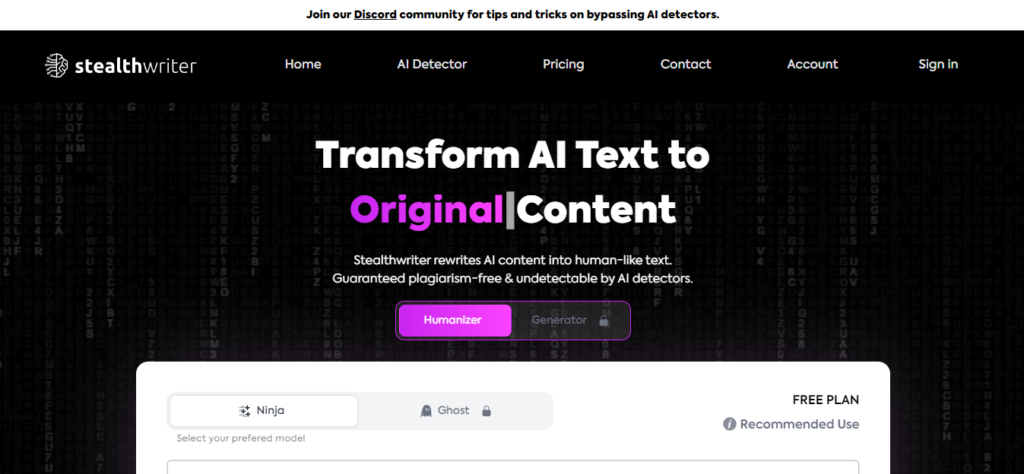
StealthWriter is a superb tool for content creators to generate human-like content. There are two modes, “Ninja” the free version & “Ghost” the paid version. This tool is also useful for SEO professionals. It offers you unique writing when you input prompts & the result bypasses the AI detection tools.
Key Features
- Supports multiple languages.
- Enhances SEO performance.
- Availability of content customization to meet specific requirements.
- Built-in AI detector to verify results conveniently.
How to Use?
Input your text or paste the AI-generated content and tap the Humanize button. Within a minute, the result will be ready.
Final Words
By following these tips on how to humanize AI content, you can create engaging content that resonates with your audience while maintaining your unique brand voice. To ensure the reliability of the AI-generated content, spend time on it to fact-check & edit the draft before final publishing.
Please note: Even Though it is important to take the help of AI to speed up the content creation process, solely depending on AI is never a good idea.
How to Humanize AI Content – Frequently Asked Questions:

Sahanaj is a content writer who is passionate about turning ideas into words that inspire positive change.



